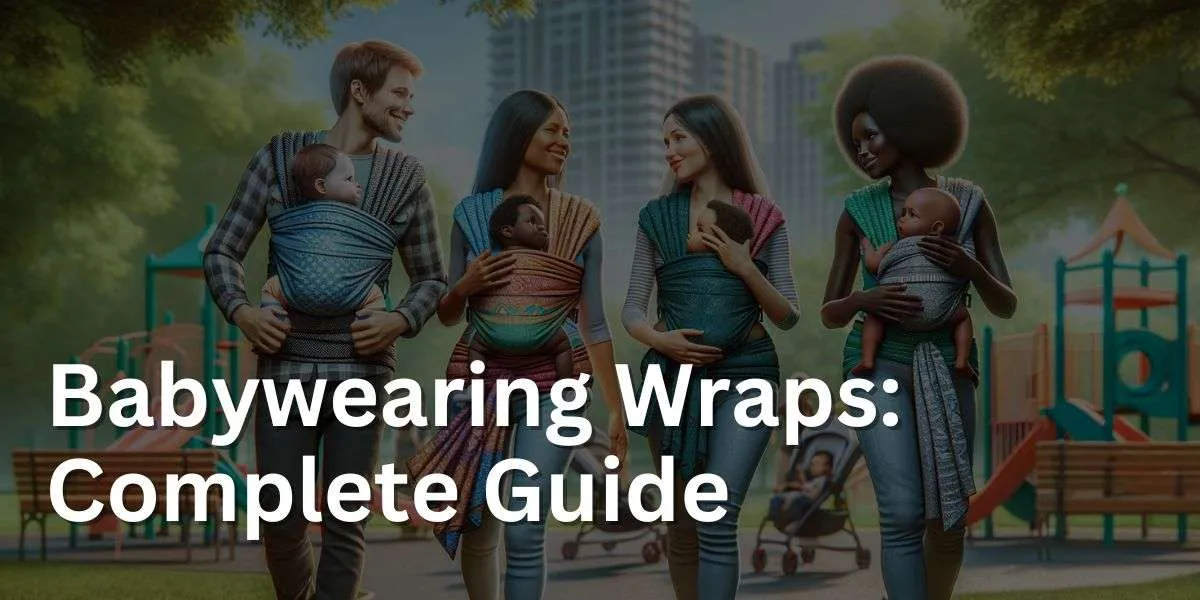Babywearing wraps offer a versatile and intimate way to carry your baby, promoting closeness and bonding between parent and child. These long pieces of fabric, when used correctly, can be one of the most comforting and natural ways to carry your little one.
We’ll discuss the different types of wraps available, including stretchy wraps for newborns and woven wraps for older babies and toddlers.
Whether you’re a new parent or considering different babywearing options, understanding the nuances of babywearing wraps can enhance your parenting journey.
Key Takeaways: Babywearing Wraps
- Wraps are long pieces of fabric used for babywearing. They offer a customizable way to carry a baby by wrapping the fabric around the parent’s body and the baby.
- Suitable for newborns and older babies. Wraps provide a snug, supportive fit that can be comforting for newborns and secure for older infants.
- Learning to use a wrap can take practice. Wrapping techniques can be complex, but with practice, they offer flexibility in how the baby is carried.
- They offer multiple carrying positions. Wraps can be tied in different ways to support front, hip, and back carries.
- Fabric choice is important. Stretchy wraps are typically better for newborns, while woven wraps are more supportive for older or heavier babies.
- Even weight distribution is a key benefit. When tied properly, wraps distribute the baby’s weight evenly across the wearer’s shoulders and back.
- Wraps encourage bonding and attachment. The close contact and snug fit promote a strong emotional connection between the parent and the baby.
- Check for safety and quality. Ensure the wrap is made from strong, high-quality materials and that you’re using it correctly to keep your baby safe.
- They can be a fashionable choice. Wraps come in various colors and patterns, offering a stylish option for parents.
- Try different types before committing. Since wraps vary in material and length, it’s helpful to try a few styles to find what works best for you and your baby.
Types of Babywearing Wraps
Babywearing wraps are an excellent way for you to bond with your baby while keeping your hands free for everyday tasks. Baby carriers come in various styles and materials, allowing you to choose the perfect baby carrier for your needs.
There are basically two types of babywearing wraps – stretchy wraps and the classic woven baby wraps. When worn correctly, with a secure fit and an ergonomic seat they are both a hip healthy product.
Stretchy Wraps
Stretchy Wraps are a popular choice, especially for new parents. These wraps are typically made from a stretchy fabric like cotton, bamboo, or blends with a small percentage of spandex or polyester.
The stretchiness adds comfort to the breathable fabric and makes it easy for you to learn the wrapping techniques. These wraps are ideal for use with newborns and infants as baby loves to be held tight which will help them fall asleep.
Stretchy materials: Materials like spandex, elastane, and Lycra are often combined with other fabrics to create stretchy wraps. These comfortable wraps, such as the Moby and Solly, offer a snug fit, adapting to your baby’s shape. Keep in mind that they’re best suited for younger babies, as their stretchiness may not provide enough support for older or heavier infants.
You can get hybrid stretchy baby carrier wraps like the baby k’tan (called the t shirt carrier), the Boba Bliss Hybrid Baby Carrier or the LÍLLÉbaby Dragonfly Wrap. See our guide on how to use a stretchy wrap here.
Woven Wraps
Woven Wraps, on the other hand, are more sturdy and don’t have as much give as stretchy wraps. This means this classic wrap will perfectly embrace your baby and conform to both of your bodies, making them comfortable for extended wear. Woven wraps are suitable for various carrying positions, like front carries, hip carries, and back carries, and can be used with heavier babies.
To help you decide which wrap is best for you and your baby, consider the following factors:
- Age and weight of your baby: Stretchy wraps are best for younger, lighter babies, while woven wraps can accommodate heavier, older babies.
- Carrying positions: Woven wraps offer more versatility in terms of carrying positions compared to stretchy wraps.
- Ease of use: If you’re new to babywearing, stretchy wraps can be easier to learn with as they can be tied to your body before placing your baby in the carrier.
- Breathability: Some wraps, especially those made from natural fibers, offer better airflow and can be more comfortable in warmer weather.
A classic baby wrap will come in various sizes from a size 2 to a size 8. See our guide to woven wraps sizes here, to work out your ‘base’ size. Once you know your base size you can then choose the best baby carrying wrap for you.
| Wrap Size | Length (meters) | Suitable For |
|---|---|---|
| Size 4 | 3.6 | Petite wearers |
| Size 5 | 4.2 | Small to medium-sized wearers |
| Size 6 | 4.6 | Medium to large-sized wearers (most common base size) |
| Size 7 | 5.2 | Large to extra-large-sized wearers |
| Size 8 | 5.6 | Extra-large or tall wearers |

Material Composition of Woven Wraps
When choosing the perfect babywearing wrap or infant wrap carrier, it’s essential to consider the material composition of the fabric. Different fabrics offer various levels of comfort, breathability, and performance. Here are some popular fabric types you may come across when looking for the ideal babywearing wrap:
Cotton: Cotton is a common and popular material for baby wraps due to its softness, breathability, and durability. It’s an excellent choice for those who prefer a natural, hypoallergenic fabric. Some woven wraps specifically use cotton due to its strength and supportiveness while still providing a comfortable and secure hold.
Bamboo: Bamboo is another breathable and lightweight fabric option. This eco-friendly material is excellent for hot weather, as it is moisture-wicking and has natural temperature-regulating properties. It is slightly stretchier than cotton, offering extra comfort but may require more frequent adjustments as your baby grows.
Linen: Linen is known for being an airy and lightweight fabric that is ideal for warm climates. With natural moisture-wicking properties, it keeps both you and your baby comfortable in hot weather. However, linen can feel a bit stiff when it’s new, but it softens over time and with frequent use.
Fit and Adjustment on Woven Wraps
When it comes to using woven wraps for babywearing, the fit and adjustment are crucial for both the parent’s comfort and the baby’s safety. Woven wraps, known for their versatility and durability, require proper technique to achieve the ideal fit.
Understanding the Fit: A well-fitted woven wrap should distribute the baby’s weight evenly across your shoulders, back, and hips. This reduces strain on any single part of your body, making it comfortable to wear for extended periods. The wrap should snugly hold the baby close to your body, as this closeness is vital for both safety and bonding. The baby’s position should allow for natural curvature of their spine, supporting their developing body correctly.
Adjusting the Wrap: To begin, find the middle of the wrap and place it against your abdomen. From here, you can follow specific wrapping techniques, such as the Front Wrap Cross Carry or the Hip Wrap Cross Carry, depending on your baby’s age and your comfort level. When tying the wrap, ensure that it’s snug but not too tight; you should be able to slip a hand between the wrap and your baby. However, the baby shouldn’t sag or slump in the wrap, as this could hinder their breathing and is uncomfortable for both of you.
Safety Checks: After wrapping, always perform safety checks. Make sure that your baby’s airway is clear and that they are in a ‘kissable’ position, meaning you can easily kiss the top of their head without straining. The fabric should support the baby from knee to knee, creating an ergonomic M-shaped position that promotes healthy hip development.
Regular Readjustments: As you move, the wrap can loosen, so it’s important to periodically check and readjust if necessary. Especially after breastfeeding or if the baby falls asleep, a quick readjustment ensures ongoing safety and comfort.
FAQs on Babywearing Wraps
What are the benefits of babywearing?
Babywearing has numerous benefits for both you and your baby. It promotes strong bonding, prevents your arms from getting tired, facilitates breastfeeding, and keeps the baby comfortable. Plus, it allows you to keep your hands free and be more productive. Learn more about the benefits and safety tips of babywearing.
How do I clean and maintain my baby wrap?
To keep your baby wrap in good condition, follow the cleaning and care instructions provided by the manufacturer. Most baby wraps can be machine-washed using mild detergent and hung to dry.
Can I use babywearing wraps if my baby was born prematurely or has respiratory issues?
The American Academy of Pediatrics (AAP) advises against using baby wraps, slings, or carriers for infants who were born prematurely or have respiratory issues, as it may cause further breathing problems. Consult your pediatrician for alternative solutions. However a baby carrier wrap can be used to faciliate skin to skin care in those early days.
Are baby wrap carriers safe for newborns?
Baby wrap carriers are safe for newborns when used correctly. They offer a snug, womb-like environment that can be soothing for newborns, promoting bonding and providing comfort. However, it’s crucial to ensure the newborn is positioned correctly to maintain an open airway. Their face should always be visible, and the wrap should support their neck and back adequately. Always follow the wrap’s guidelines for safe usage.
At what age can you put a baby in a wrap carrier?
You can put a baby in a wrap carrier from birth, as long as the wrap is suitable for newborns and used correctly. Newborns need to be carried in a way that supports their neck and spine and allows for easy breathing. The wrap should allow the baby to be in a comfortable, ergonomic position, close enough to the wearer to kiss their head.
What are the cons of baby wraps?
The cons of baby wraps include:
- Learning Curve: They can have a steeper learning curve for correct usage, which might be challenging for some parents.
- Comfort Over Time: For the wearer, they might become uncomfortable over longer periods, especially as the baby grows and gains weight.
- Temperature Regulation: Wraps can be warm, making them potentially uncomfortable in hot weather for both the baby and the wearer.
- Limited Positions: Some wraps offer fewer carrying positions compared to structured carriers, especially for older babies.
What is the minimum weight for a baby wrap carrier?
The minimum weight for a baby wrap carrier typically starts at around 5 pounds (2.3 kg), suitable for most newborns. However, it’s important to check the specific guidelines provided by the wrap manufacturer, as some wraps are designed to be more supportive for preemies or low birth weight babies.
Is wrapping newborn safe?
Wrapping a newborn is safe when done properly, with careful attention to their positioning and comfort. It’s essential to ensure the newborn’s airway is clear and their body is supported in a natural, ergonomic position in baby slings or baby carriers. The newborn’s head should be supported, and the wrap should be snug but not too tight. Always follow safety guidelines for wrapping a newborn to ensure their safety and well-being.











